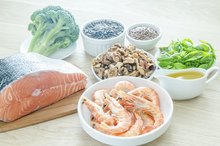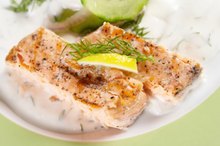What does fact checked mean?
At Healthfully, we strive to deliver objective content that is accurate and up-to-date. Our team periodically reviews articles in order to ensure content quality. The sources cited below consist of evidence from peer-reviewed journals, prominent medical organizations, academic associations, and government data.
The information contained on this site is for informational purposes only, and should not be used as a substitute for the advice of a professional health care provider. Please check with the appropriate physician regarding health questions and concerns. Although we strive to deliver accurate and up-to-date information, no guarantee to that effect is made.
Omega-3s & Mahi Mahi
The name "mahi mahi" means "strong strong" in Polynesian. Mahi fish get this fierce name because they have few predators and can survive in several climates. These fish live in tropical and subtropical climates worldwide. Since these fish live in warmer waters, they do not have as much body fat as cold-water fish, such as salmon. While mahi mahi may not provide as much omega-3s as cold-water fish, they are still considered a good source of this essential fatty acid.
Fat in the Diet
Your body needs fat to produce certain hormones and to absorb the fat-soluble vitamins: A, D, E and K. Around 20 to 35 percent of your total calories should come from fat, suggests MayoClinic.com. Fats are a concentrated energy source and provide 9 calories per gram. You need 44 to 77 g of fat if you consume a 2,000-calorie diet. While fats, including omega-3s, are an essential part of your diet, some fats are better for you than others. You can determine the types of fats in the foods you eat by reading the nutrition facts label. Avoid foods that have large amounts of saturated and trans fats. These unhealthy fats can increase your risk factors for heart disease. Mahi mahi is full of healthy fats, such as monounsaturated and polyunsaturated fats, or MUFAs and PUFAs.
- Your body needs fat to produce certain hormones and to absorb the fat-soluble vitamins: A, D, E and K. Around 20 to 35 percent of your total calories should come from fat, suggests MayoClinic.com.
Omega-3 Fatty Acids
Fish Containing Highest Levels of EPA & DHA
Learn More
Omega-3 fatty acids are a type of polyunsaturated fat 2. They are essential for your growth and health, but your body cannot make them and you need to consume foods rich in omega-3s. These fatty acids reduce inflammation in the body and can minimize risk factors associated with heart disease. Omega-3s also play a role in memory and brain function, since the majority of them are concentrated in the brain, explains the University of Maryland. The two most common types of omega-3s are alpha linolenic acid, or ALA, and docosahexaenoic acid, or DHA. Both types are important, and you need equal amounts of both for optimal health.
- Omega-3 fatty acids are a type of polyunsaturated fat 2.
- They are essential for your growth and health, but your body cannot make them and you need to consume foods rich in omega-3s.
Mahi Mahi and Omega-3
According to the American Heart Association, you should eat fish at least twice per week 1. One serving of fish is around 3 to 4 oz. Enjoying a 3 oz. fillet of mahi mahi provides .13 g of omega-3 fatty acids 12. While there are no guidelines to determine how much omega-3 you need in your diet each day, you should not consume more than 3 g.
Additional Nutrients
Comparison of Omega 3 in Herring and Salmon
Learn More
Mahi mahi is a source of several additional nutrients. All cells in your body utilize protein to make and maintain new tissues. This lean fish provides around 15 g of protein per 3 oz. serving. Vitamins B6, B12 and niacin are high in mahi fish, says the National Oceanic and Atmospheric Administration 3. These water-soluble B vitamins are important for metabolism and help your body get energy from the foods you eat.
- Mahi mahi is a source of several additional nutrients.
- These water-soluble B vitamins are important for metabolism and help your body get energy from the foods you eat.
Related Articles
References
- American Heart Association; Fish, Levels of Mercury and Omega-3 Fatty Acids
- University of Maryland Medical Center; Omega-3 Fatty Acids; June 2009
- National Oceanic and Atmospheric Administration; Mahi-Mahi; February 2010
- Jouris, K. B., McDaniel, J. L., & Weiss, E. P. (2011). The effect of omega-3 fatty acid supplementation on the inflammatory response to eccentric strength exercise. Journal of Sports Science & Medicine, 10(3), 432.
- Tartibian, B., Maleki, B. H., & Abbasi, A. (2009). The effects of ingestion of omega-3 fatty acids on perceived pain and external symptoms of delayed onset muscle soreness in untrained men. Clinical Journal of Sport Medicine, 19(2), 115-119.
- Parra, D., Ramel, A., Bandarra, N., Kiely, M., MartÃnez, J. A., & Thorsdottir, I. (2008). A diet rich in long chain omega-3 fatty acids modulates satiety in overweight and obese volunteers during weight loss. Appetite, 51(3), 676-680.
- Omega-3 Fatty Acids. (2016). Retrieved January 18, 2018, from http://ods.od.nih.gov/factsheets/Omega3FattyAcidsandHealth-HealthProfessional/
- Daley, C. A., Abbott, A., Doyle, P. S., Nader, G. A., & Larson, S. (2010). A review of fatty acid profiles and antioxidant content in grass-fed and grain-fed beef. Nutrition Journal, 9(1), 10.
- Covington, M. B. (2004). Omega-3 fatty acids. Atlantic, 1(2.0)
Writer Bio
Melodie Anne Coffman specializes in overall wellness, with particular interests in women's health and personal defense. She holds a master's degree in food science and human nutrition and is a certified instructor through the NRA. Coffman is pursuing her personal trainer certification in 2015.









